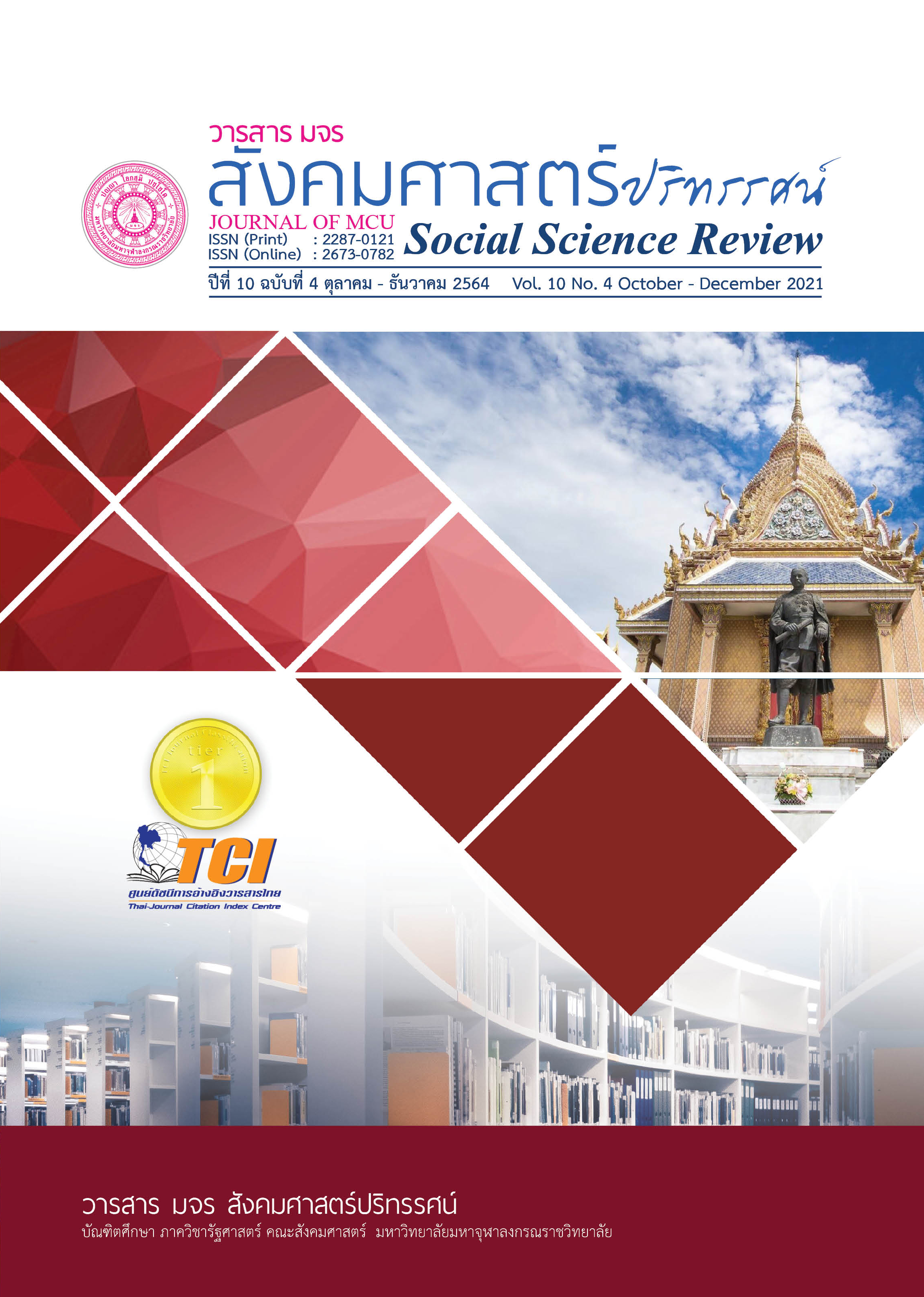การพัฒนาสินค้าของที่ระลึกที่สะท้อนอัตลักษณ์ของแหล่งท่องเที่ยว
คำสำคัญ:
การพัฒนาผลิตภัณฑ์, สินค้าของที่ระลึก, อัตลักษณ์ของแหล่งท่องเที่ยวบทคัดย่อ
การท่องเที่ยวของไทยนับเป็นอุตสาหกรรมหลักที่พัฒนาอย่างรวดเร็วและสร้างรายได้มหาศาลให้กับประเทศ แต่ถึงกระนั้นส่วนประกอบสำคัญหนึ่งในอุตสาหกรรมท่องเที่ยว คือธุรกิจการผลิตของฝากของที่ระลึก กลับยังพัฒนาไปไม่ทันความก้าวหน้าและต้องการของนักท่องเที่ยวที่เปลี่ยนแปลงไป การสืบค้นจากวรรณกรรมและลงพื้นที่สำรวจตามแหล่งท่องเที่ยวต่าง ๆของไทย ทำให้ได้ทราบว่าสินค้าของที่ระลึกที่วางจำหน่ายอยู่ในปัจจุบันนั้น ยังไม่สามารถสะท้อนถึงอัตลักษณ์วัฒนธรรมของแหล่งท่องเที่ยวได้เท่าที่ควร อีกทั้งบางส่วนมีรูปแบบไม่ทันสมัย ไม่โดดเด่นเพียงพอที่จะดึงดูดใจให้นักท่องเที่ยวตัดสินใจซื้อได้ทั้ง ๆ ที่ประเทศไทยมีทรัพยากรและมรดกทางวัฒนธรรมอยู่จำนวนมาก ที่สามารถจะนำมาสร้างสรรค์ลงในตัวผลิตภัณฑ์สินค้าของที่ระลึกได้ ดังนั้นผู้ประกอบการธุรกิจท่องเที่ยวและกลุ่มอาชีพในชุมชนท้องถิ่น จึงควรหันมาศึกษา เรียนรู้เกี่ยวกับการพัฒนารูปแบบผลิตภัณฑ์สินค้าของที่ระลึกในปัจจุบันให้มีเสน่ห์ มีลวดลายและรูปทรงที่ทันสมัย โดยการประยุกต์ใช้เทคนิค SCAMPER ซึ่งเป็นเทคนิคสมัยใหม่ ร่วมกับการนำเอาอัตลักษณ์ทางวัฒนธรรมมาออกแบบสินค้าวัฒนธรรม เช่น การนำลวดลายจากจิตกรรมฝาผนังวัดมาออกแบบเป็นโมเดลตั้งโชว์, การนำหัตกรรมท้องถิ่นและวัสดุพื้นถิ่นมาสร้างสรรค์เป็นของที่ระลึก, การออกแบบผลิตภัณฑ์โดยใช้รูปทรงสัณฐานเป็นแนวคิดการออกแบบของที่ระลึก, การออกแบบผลิตภัณฑ์ที่ใช้ตำแหน่งที่ตั้งตรงกันมาสร้างเอกลักษณ์ให้กับของที่ระลึก และการออกแบบผลิตภัณฑ์โดยนำแนวคิดการนำเอาเอกลักษณ์ความงดงามตามธรรมชาติผสมกับความทันสมัย เพื่อเป็นการเพิ่มมูลค่าให้กับสินค้าของที่ระลึก อีกทั้งยังสร้างการรับรู้และตอบสนองความต้องการของนักท่องเที่ยว จนนำไปสู่การสร้างอาชีพสร้างรายได้ให้คนในท้องถิ่น
เอกสารอ้างอิง
จุฑาทิพย์ ทิพย์เหรียญ. (2559). พฤติกรรมการซื้อของฝากของนักท่องเที่ยวชาวจีนแบบอิสระในเขตกรุงเทพมหานคร (วิทยานิพนธ์บริหารธุรกิจมหาบัณฑิต). กรุงเทพฯ: มหาวิทยาลัยธรรมศาสตร์.
ดิเรก ปัทมสิริวัฒน์. (2547). ทุนทางสังคมและทุนทางวัฒนธรรมในระบบเศรษฐกิจและการจัดการยุคใหม่. กรุงเทพฯ: พี.เอ.ลีฟวิ่ง.
ตวงรัก รัตนพันธุ์และชัชวาลย์ รัตนพันธุ์. (2560). การออกแบบของที่ระลึก : การประยุกต์ใช้ภูมิปัญญาท้องถิ่นสู่ผลิตภัณฑ์ชุมชน. วารสารนาคบุตรปริทรรศน์, 9(1), 1-14.
นิรชา ศรีภิลาและกิตติศักดิ์ ธรรมศักดิ์ชัย. (2563). การออกแบบบรรจุภัณฑ์และตราสินค้าผลิตภัณฑ์ของที่ระลึกฮายักษ์. วารสารศิลปกรรมและการออกแบบแห่งเอเชีย, 2(1), 56-75.
ราชบัณฑิตสถาน. (2556). พจนานุกรมราชบัณฑิตสถาน พ.ศ.2554 (พิมพ์ครั้งที่ 2). กรุงเทพฯ: นามมีบุ๊ค.
ไพโรจน์ ธีระประภา. (2558). อัตลักษณ์ของที่ระลึกและกราฟฟิกดีไซน์สะท้อนพื้นถิ่น. สืบค้น 18 มิถุนายน 2564, จาก http://www.bundanthai.com/th/news/9
ไพโรจน์ พิทยเมธี. (2558). ฝากไทย:ถอดรหัสเสน่ห์ของที่ระลึกเพื่อการท่องเที่ยว ศูนย์บันดาลไทย กระทรวงวัฒนธรรม. สืบค้น 19 มิถุนายน 2564, จาก https://www.m-culture.go.th/adminli/ebook/B0068/?fbclid=IwAR2ItbVU4KfL_HtMfd1X05oCjGZVQf8PT8XW5EqGnOb2qUsbF pwgtS8H_zU#p=1
มิ่งสรรพ์ ขาวสอาด. (2563). Tourism Economic Review : ทิศทางท่องเที่ยวไทยหลังวิกฤตโควิด-19. รายงานภาวะเศรษฐกิจการท่องเที่ยว, 1(4),43.
สุกฤตา หิรัณยชวลิต. (2559). นวัตกรรมของฝากจากทุนทางวัฒนธรรม. วารสารนักบริหาร, 36(2), 14-23.
อภิญญา เฟื่องฟูสกุล. (2546). อัตลักษณ์ : การทบทวนทฤษฎีและกรอบแนวคิด = Identity. กรุงเทพฯ: สำนักงานคณะกรรมการวิจัยแห่งชาติ.
Anderson & Littrell. (1995). Souvenir-Purchase Behavior of Women Tourists, Annals of Tourism Research, 22(2), 328-348.
Boudieu, P. (1986). The Forms of Capital. In J. Richardson (Ed.) Handbook of Theory and Research for the Sociology of Education, New York: Greenwood, 241-258.
Hall, S. (1994). Representation: Cultural Representations and Signifying Practices. London: Sage.
LIGHTFOG Creative & Design. (2558). ฝากไทย:ถอดรหัสเสน่ห์ของที่ระลึกเพื่อการท่องเที่ยว ศูนย์บันดาลไทย กระทรวงวัฒนธรรม. สืบค้น 19 มิถุนายน 2564, จาก https://www.m-culture.go.th/adminli/ebook
Sun, Y. X. (2560). การออกแบบผลิตภัณฑ์ของที่ระลึกสะท้อนเอกลักษณ์พื้นถิ่นชุดศิลปะเต๋าแห่งเขาเหลาซาน (วิทยานิพนธ์ศิลปะศาสตร์มหาบัณฑิต). ชลบุรี: มหาวิทยาลัยบูรพา.
Throsby, D. (2001). Economy and Culture. Cambridge: The Press Syndicate of the University of Cambridge.
UNWTO. (2564). World Tourism Barometer: การจัดลำดับประเทศที่มีรายได้จากการท่องเที่ยวสูงสุด 10 อันดับแรกในปี 2018. สืบค้น 20 มิถุนายน 2564, จาก https://th.wikinew.wiki/wiki/World_Tourism_rankings
ดาวน์โหลด
เผยแพร่แล้ว
รูปแบบการอ้างอิง
ฉบับ
ประเภทบทความ
สัญญาอนุญาต
ลิขสิทธิ์ (c) 2021 วารสาร มจร สังคมศาสตร์ปริทรรศน์

อนุญาตภายใต้เงื่อนไข Creative Commons Attribution-NonCommercial-NoDerivatives 4.0 International License.
เพื่อให้เป็นไปตามกฎหมายลิขสิทธิ์ ผู้นิพนธ์ทุกท่านต้องลงลายมือชื่อในแบบฟอร์มใบมอบลิขสิทธิ์บทความให้แก่วารสารฯ พร้อมกับบทความต้นฉบับที่ได้แก้ไขครั้งสุดท้าย นอกจากนี้ ผู้นิพนธ์ทุกท่านต้องยืนยันว่าบทความต้นฉบับที่ส่งมาตีพิมพ์นั้น ได้ส่งมาตีพิมพ์เฉพาะในวารสาร มจร สังคมศาสตร์ปริทรรศน์ เพียงแห่งเดียวเท่านั้น หากมีการใช้ภาพหรือตารางหรือเนื้อหาอื่นๆ ของผู้นิพนธ์อื่นที่ปรากฏในสิ่งตีพิมพ์อื่นมาแล้ว ผู้นิพนธ์ต้องขออนุญาตเจ้าของลิขสิทธิ์ก่อน พร้อมทั้งแสดงหนังสือที่ได้รับการยินยอมต่อบรรณาธิการ ก่อนที่บทความจะได้รับการตีพิมพ์ หากไม่เป็นไปตามข้อกำหนดเบื้องต้น ทางวารสารจะถอดบทความของท่านออกโดยไม่มีข้อยกเว้นใดๆ ทั้งสิ้น





